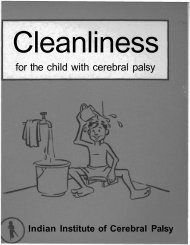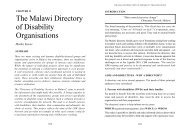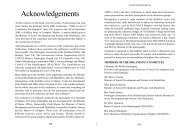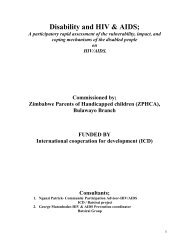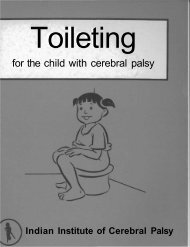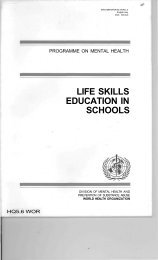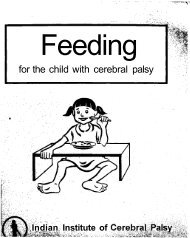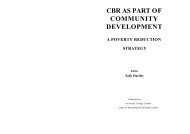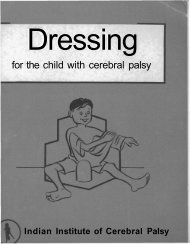Some Controversies in Community Based Rehabilitation - Source
Some Controversies in Community Based Rehabilitation - Source
Some Controversies in Community Based Rehabilitation - Source
Create successful ePaper yourself
Turn your PDF publications into a flip-book with our unique Google optimized e-Paper software.
SOME CONTROVERSIES IN CBR<br />
unlikely to be achieved <strong>in</strong> the foreseeable future. There is also a suspicion<br />
<strong>in</strong> the m<strong>in</strong>ds of many people, that the rhetoric of ‘community participation’<br />
is used by governments as a ploy to abdicate their responsibility, because<br />
the taxes collected are spent on causes other than development.<br />
The oppos<strong>in</strong>g argument is that CBR is a developmental issue and as<br />
such, it needs to be <strong>in</strong>itiated by the concerned groups themselves, who<br />
<strong>in</strong> this case are people with disabilities and their family members (Miles,<br />
1999, Werner, 1995). If it is externally <strong>in</strong>itiated, the clients will cont<strong>in</strong>ue<br />
to rema<strong>in</strong> passive recipients of services, with expectations of charity,<br />
and without the <strong>in</strong>itiative to manage their own affairs and to contribute<br />
to society.<br />
S<strong>in</strong>ce people <strong>in</strong> develop<strong>in</strong>g countries are largely ignorant about consumer<br />
ownership of development programmes, it is not feasible <strong>in</strong> most<br />
<strong>in</strong>stances to beg<strong>in</strong> the programme with full ownership by the communities<br />
(Thomas and Thomas, 2001). There is however, a possibility of strik<strong>in</strong>g<br />
a balance between the two oppos<strong>in</strong>g arguments. CBR programmes will<br />
need to motivate the local community to participate <strong>in</strong> their development<br />
to beg<strong>in</strong> with, and over time, to shoulder the responsibilities of the<br />
programme. In this process, the community will gradually acquire the<br />
management skills to take over their programmes as well (Thomas and<br />
Thomas, 2001).<br />
WILL THE SOCIAL MODEL OF CBR IGNORE THE ‘REAL<br />
REHABILITATION’ NEEDS OF PEOPLE WITH DISABILITIES<br />
When CBR was <strong>in</strong>itially promoted by WHO, it was to be <strong>in</strong>tegrated <strong>in</strong>to<br />
the PHC system, and thus many early CBR programmes followed a<br />
medical model, which came <strong>in</strong> for criticism <strong>in</strong> the eighties as not be<strong>in</strong>g<br />
sufficiently sensitive to all the needs of people with disabilities (Lang,<br />
2000). As a result, most CBR programmes evolved subsequently as<br />
separate programmes address<strong>in</strong>g an array of needs, <strong>in</strong> a comprehensive<br />
manner. The perception then, was that unless a special focus was given<br />
to disability, the ‘specialised’ needs of people with disabilities would<br />
rema<strong>in</strong> unmet (Thomas and Thomas, 1998). However, with the shift from<br />
17



